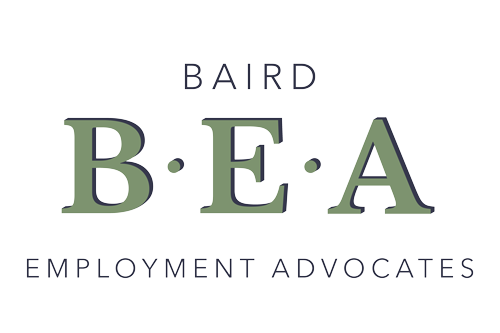Any time an employer chooses to dismiss an employee for unsatisfactory work performance or conduct, where eligible (eg: not employed by a Small Business – less than 15 employees), there is potential for the employee who has had their employment terminated to make an application for unfair dismissal in the Fair Work Commission. There are steps that can be taken to ensure the construction of a lawful termination of employment to protect the employer.
Employees can also contend that their dismissal was unlawful, and make an application under the General Protections provisions. This article will not cover such circumstances, but we will discuss that subject in another article.
Minimal Criteria for an unfair dismissal application
There are some minimal criteria that must be satisfied for an unfair dismissal application to be lodged by an ex-employee:
- An employee must have been employed by the employer for a minimum of 6 months.
- A termination of employment (or a forced resignation), must have occurred.
- An application must have been lodged within 21 days after the termination date.
- Be covered by the national workplace relations system.
- They must earn less than the High Income Threshold, currently $153,600 per annum.
Provided these criteria are satisfied, along with a $74.50 fee, an unfair dismissal application can be initiated. Individuals can enlist the services of a lawyer, paid agent or advocate to complete and lodge the written submission, and speak on their behalf on the day of the conciliation conference.
Briefly, an unfair dismissal application will seek to provide a “remedy” to the Applicant (the ex-employee) that could include reinstatement, a statement of service, an opportunity to convert a dismissal to a resignation and of course, a financial component.
They can be pursued individually, or as various combinations. The reality is that unless employers have an absolute water tight defense, the likelihood is that one or a number of these remedies will be negotiated and agreed to. The aim must be to minimize an employers exposure, and have a sound position to argue from.
Again, the purpose of this article is not to cover off on the application or Fair Work process, this subject will be expanded on in a further article. It’s purpose more so is to discuss the elements that an employer must have in place to justify a dismissal, and ensure that exposure to an unfair dismissal application is minimized, and further, that exposure to any remedy sought can either be refuted entirely, or at the least, at the best lower end of what is being sought.
Contact BEA to find out how we can help you construct a lawful termination of employment
Reasoning for termination of employment
So, let’s assume the “relationship” between an employer and employee is about to or has ended. Other than the employee choosing to resign and pursue other career choices, it is generally because there has been a work performance or conduct issue or issues, that are so serious, that the continuation of the employment contract is rendered untenable.
At this point, termination of employment may be a very real consideration for an employer.
There may have been a history of poor conduct or work performance precluding the decision to terminate the employment, effectively ending the contract of employment, and the binding terms and conditions that such an Agreement will obligate each party to comply with.
Conversely, there may have been a single, serious incident or event, for example theft, fraud or assault, that lead to an employer considering that termination of employment is the only outcome available.
Either way, there is or has been an act or omission, which we will cover off on later in this article, and it follows, a consequence as a result of the act or omission. These components are necessary to generate a “valid reason”.
As an example, if a driver without warning or obvious reason, brakes very heavily and causes the vehicle travelling behind to collide with rear of his vehicle. We have an act (they did something), and a consequence,(a definable result or outcome) the vehicle travelling behind collided with the vehicle in front.
Conversely, if a driver traveling behind another vehicle fails to apply the brakes on approach to a set of traffic lights that have turned red, and subsequently collides with the vehicle in front, we have an omission (a failure to do something), and a consequence (a definable result or outcome), being the collision with the rear of the vehicle travelling in front.
And finally, there may have been an act or omission, but with no consequence. For example, the driver braked heavily and without warning, but there was no other vehicle travelling behind. There was no consequence.
Once the elements (either an act or an omission) in relation to an employees work or conduct are established and proven, and there is a measurable or definable (loss of revenue, customer etc) consequence, employers will have a valid reason in place.
Act/Omission = Consequence = Valid Reason
If an employee makes an Unfair Dismissal application to challenge the dismissal, the employee will look to assert that either there was no valid reason, or that the dismissal was harsh, unjust or unreasonable (they sound the same, but there are differences). Again, these elements can be contended individually or as a combination.
It is important to understand that there may be a valid reason, but if the dismissal or historical disciplinary process leading to the dismissal was not managed properly (procedurally fair), the unfair dismissal application may still give rise to a finding that it was harsh, unjust or unreasonable. Section 387 of the Fair Work Act provides a guide as to the definitions around these considerations.
It may be that the dismissal is:
- harsh but not unjust or unreasonable,
- unjust but not harsh or unreasonable, or
- unreasonable but not harsh or unjust.
A dismissal may be:
- unjust because the employee was not guilty of the alleged misconduct,
- unreasonable because the evidence or material from the act or omission before the employer did not validate the conclusion,
- harsh on the employee due to the economic and personal consequences resulting from being dismissed, or
- harsh because the outcome is disproportionate to the gravity of the misconduct (minimal or no consequence arose).
For employers, navigating your way through a consideration to dismiss an employee, and then preparing and defending your decision and process in the Fair Work Commission against an unfair dismissal application can be complex, and expose your business to paying more in remedy than what you may need to.
How can BEA help you?
BEA can provide you with sound advice, and if required, manage the unfair dismissal pre-conference submission and representation on your behalf. We can also undertake an audit of your processes, policies and documentation to ensure that in a procedural sense, what you have in place is best practice and compliant with the provisions of the Fair Work Act.
Contact BEA to find out how we can help you construct a lawful termination of employment


